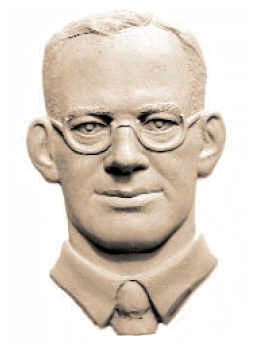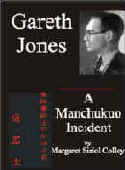Gareth Jones
[bas relief by Oleh Lesiuk]
HOME |
Stop Press |
Complete Soviet Articles & Background Information |
Précis of Gareth's
|
All Published Articles |
BOOKS
|
|
|
|
More Than Grain of Truth(2005) |
|
|
TOPICAL
'Are you Listening NYT?' U.N. Speech - Nov 2009 |
Gareth Recognised at Cambridge - Nov 2009 |
Reporter and the Genocide - Rome, March 2009 |
Order of Freedom Award -Nov 2008 |
Premiere of 'The Living' Documentary Kyiv - Nov 2008 |
Gareth Jones 'Famine' Diaries - Chicago 2008 |
Aberystwyth Memorial Plaque 2006 |
GENERAL
Scholarship Fund |
Site Map |
Links |
Legal Notices |
Sponsored Links |
Contact |
The Times Leader October 13th 1930
THE TWO RUSSIAS
- - -
1.- RULERS AND RULED
- - -
Below
the surface
The brief series of articles begun below records impressions recently gathered by an unshephered visitor to Russia who was able to collect at first hand some rank-and-file opinion on the regime and its policies.
(From a Correspondent)
Visitors to Tsarist Russia often returned to England impressed with the apparent loyalty of the whole population to the Emperor and entirely unaware of the rapidly growing discontent which was seething beneath the surface. Today history is repeating itself. Groups of tourists, biased from the very beginning in favour of the “workers’ paradise,” are being shown by competent and charming guides the facade of Soviet Russia and leave the country enthusiastic over the success of the Socialistic experiment. Not possessing the slightest knowledge of the language, and meeting few people other than active Communists, they leap to the conclusion that the majority of that they meet are ardent supporters of the present régime. The politeness of Communist Officials, and their willingness to spare no trouble in impressing their guests, disarm criticism and leave the foreign delegations blissfully ignorant of the hunger, discontent, opposition, and hatred which in the last few months have been steadily growing in intensity and are spreading through all parts of the Soviet Union and through all sections of the community.
Few observers of the Soviet Russia are worthy of credence unless they can understand and speak Russian, unless they have carefully studied the Bolshevist Press, and have had contacts not only with that numerically insignificant section the Communist Party, but also with peasants, miners, nobles, restaurant workers, private traders, priests, Civil servants, and engineers. In estimating the importance of the opinion expressed by Russians the character and position of the speakers should be taken into consideration on the presumption that a miner escaping from the Donetz Basin, where there has been a serious breakdown in food supplies, is far more likely to exaggerate the gravity of the situation than a well-paid specialist working in the electrical industry, which is making great progress. The following estimate of the state of affairs in Russia has been made on these methods during a recent visit to the Soviet Union, and the conversations quoted in the following articles were written down at the earliest possible moment after the Russian had left the writer’s presence.
THE
TWO VIEWS
In a vast country under the “dictatorship of the proletariat” where the ballot box plays little part, it is difficult to draw a conclusion as to the exact amount of support which the régime has from the population, especially when that support varies according to such consideration as the quantity of meat or grain received in a certain town or the price of butter in a certain market. The population seems, however, to be divided into two sections, the “active”, that is “the rulers” composed of less than 10 percent., and the “non-active,” that is “the ruled” composed of more than 90 percent. of the total. Whereas most of the “active”, the 10% section, consisting of the members of the Party and of youth organisations, are filled with an enthusiasm, unknown in any other group of people save perhaps the National Socialists of Germany, the Fascist and the Salvation Army, the “non-active” 90 percent are thoroughly disillusioned, have lost faith in the Five-Years Plan and dread the return in the coming winter of the conditions which reigned in 1918 and 1919.
Most of the active minority are young in age and young in spirit. Many of them who are now 20 were only seven years old when the October Revolution broke out, and have no conception of life in a capitalist country. Having passed through the Communist training grounds of the Pioneers (the Communist Boy Scouts) and the Komsomol (the League of Communist Youth), they have had Leninism stamped upon them and have been educated to believe in the inevitability of the world revolution and of the forthcoming war which they are taught, the capitalists will wage war on Soviet Russia. Many are impatient with what they consider the slow progress of socialisation in Russia. As a working woman said: “The old people think that the Five-Years Plan is going too quickly, but for the young people it is not going quickly enough.” The millennium must come at once and every remnant of capitalism must disappear. The Party, in their view, must not be guilty of any leniency either towards the class enemies at home or towards the Imperialist abroad. A conversation with among Red Army commander will best illustrate the attitude of the rulers of Russia: “We must be strong and show no mercy. We are not a tender-hearted set of people. We must not hesitate, for example, to crush the kulaks and send them to cut wood in the forests of the north.”
THE
FIVE-YEARS PLAN
The active minority firmly believes that ultimately Communism will be victorious. To attain this victory in Russia their method is the Five-Years Plan (October 1, 1928 to September 30, 1933), which has a threefold object – rapid industrialisation, complete collectivisation of agriculture, and the elimination of all capitalist elements in the country. The State Planning Commission, in collaboration with the whole country, prepares a vast plan for the whole country, for each district and for each factory. Thus the economic system is highly centralised and the means of production in industry are already almost entirely in the hands of the State. The whole energies of the ruling body are concentrated upon the execution of the Five-Years Plan, and all national activities, from education to art, are subordinated to one object, the rapid and complete socialisation of the Soviet Union.
One of the main weapons in the hands of the active section of the population is, of course, propaganda, from which one cannot escape wherever one may go. In the train one reads in large letters: “Let us reply to the furious arming of the capitalists by carrying out the Five-Years Plan in four years. Across the streets large red and white banners are stretched upon which are inscribed: “The capitalist of the West are preparing war on the Soviet Union,” or “Let us destroy illiteracy.” Sitting in any co-operative restaurant one sees on all sides pictures of Lenin, Stalin and Kalinin, and such appeals as: “On May 1st remember the oppressed workers of the capitalist countries.” In a factory, besides excellent posters on health and accidents, there are such notices as: “God and the drunkard are the enemies of the Five-Years Plan,” or “All, all all, come to a meeting on August 1 to hear a report of a comrade of the Third International who has come from Germany and other countries.” Outside the Tretyakovskaya Art Gallery in Moscow the following slogan strikes the visitor: “Art is a weapon of class warfare.” Upon the House of Soviets the following words are written upon a banner: “To Capitalism, the international revolutionary movement brings not peace but the sword.” Finally, upon the china in the Hotel Metropole, mainly frequented by foreigners, are the words, “Workers of the world, unite.”
Besides posters, there are other more effective propaganda methods. The theatre is an implement for the socialisation of the country. The film industry, of whose success the U.S.S.R. is justly proud, has as its aim the spreading of Communism. The museums, which are artistically arranged and admirably kept, all teach one lesson, the evil of Capitalism and the glories of the revolution. Even such a minor institution as a shooting range must have its political use; thus the targets are the Tsar, a priest, a kulak (a peasant owning more than three cows), a Chinaman, and a drunkard.
THE
SHOCK BRIGADES
To speed up production and to carry out the Five-Years Plan, two important methods are the shock brigade and socialist competition. The shock brigades are groups of energetic and enthusiastic Communists who offer their services free of charge to the State and who rally the other workers to carry out or to exceed the plan of the factory or mine. Many thousands have been sent out to the villages, where they arouse the enmity of the peasants by their vigour and ruthlessness in forcing the households too rapidly into collective farms. Socialist competition, by which factories or workshops enter upon a contract to race each other in production, has come to play the same part among Communist workers as football rivals in Great Britain.
How far have these attempts to convert Russia into an industrialised country succeeded? In some branches of industries the boast of the Communists are fully justified. The power development of the electrified industry are tremendous and the quality of the materials used and of the products is far better than in other industries. The telephone system, for example, works well. The increased sales of Russian oil testify to the development of the Baku district. Aviation is progressing rapidly and a Trans-Siberian air route is being planned which will bring London, within a few days of Japan and thus revolutionise the postal services. New factories, mines and furnaces are being constructed everywhere. The State Publishing Company has created a network of bookshops throughout the country with vast sales of books at low prices.
TRUTH AND STATISTICS
There are many things, however, which the Soviet figures do not show. Statistics conceal the poor materials used in many of the factories, such as the Putilov tractor factory, the bad quality of the boots and clothes and other goods produced, the correct way in which some of the figures are compiled and the failure to provide some factories with raw materials, with transport facilities or with engineers. Much expensive imported machinery is ruined by being treated with recklessness. Moreover, there is a great wastage of brainpower, since a man’s political keenness is often more important than his business ability and an expert may lose his post because of his bourgeois parents. To counter balance many of these drawbacks are unbounded faith, energy, vigour, and ruthlessness of the Communists.
In spite of the success attained in some branches of Soviet Industry, Russia remains a poor and discontented country. In the last few months, the Five-Years Plan has met with a check and in many districts, especially the Donetz Basin, there have been many breakdowns. Food difficulties arising from the slaughter of animals which followed he violent collectivisation campaign in January and February, and from the Soviet policy of exporting foodstuffs to obtain credit at all costs, are already putting a brake on the progress of industrialisation, as is proved by the decision to postpone the beginning of the Third Year of the Plan from October to January. This winter the difficulties confronting the Five-Years Plan will be greater than ever for thousand of workers are already returning from the towns to the villages and many will be too weak to work.
The optimism of the active Communists and their belief that Russia will in one or two years time be prosperous cannot be justified. Far nearer to the truth are the views of the rank and file, of the non-active workers and peasants. The next article will show by quotations from actual conversations how great is the gulf between the rulers and the ruled and how widely their expectations of the future differ.
|
|
|
|



